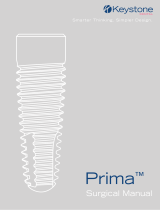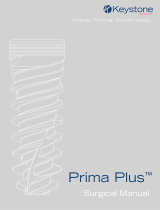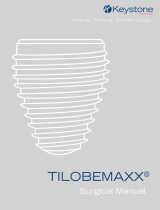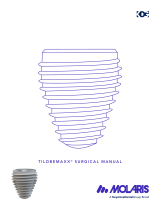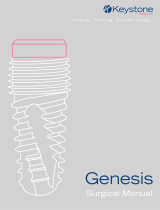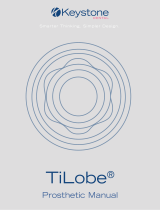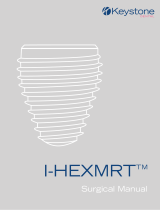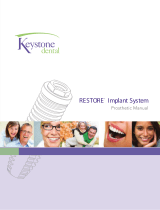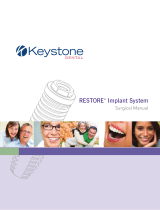Page is loading ...

Tapered Prima
TM
Guided Surgery Manual
Smarter Thinking. Simpler Design.


3
TAPERED PRIMA
TM
GUIDED SURGERY
SURGERY
Keystone Guided Surgery Kit
4
Getting Started
5
Guided Surgery: Surgical Progression
5
Instructions for Use
6
Instrument Care
7
Surgical Kit Overview
8
Drill Overview
11
Guided Surgery Drilling Protocols
11
Tapered Prima Guided Surgery Sequence
12
Product specifications are subject to change without notice.
Items illustrated are not to scale.
TABLE OF CONTENTS

4
PRECISION IMPLANT PLACEMENT
The Prima Guided Surgery Kit is intended for the placement of 3.5 mm to 5.0 mm PrimaConnex Tapered Implants.
Keystone Guided Surgery Kit - 15651K
Ø3.5 mm Ø4.1 mm
Ø2.7 mm Ø3.3 mmØ2.4 mm
Ø3.5 mm Ø4.1 mm
Ø5.0 mm
Collar
2.2 mm
Collar
2.3 mm
Collar
2.4 mm
Ø5.0 mm
L
L
L
TAPERED PRIMA
™
GUIDED SURGERY

5
Getting Started
Tapered Prima Guided Surgery requires access to CT planning software, as well as a Cone Beam Scanner or CT
Scanner. Software training is essential for all clinicians and technicians involved in the treatment planning process. It
is recommended to fabricate a radiopaque scan template with the desired tooth/teeth position when seated intra-orally
during the CT scan.
SOFTWARE COMPATIBILITY
The Tapered Prima Guided Surgery Kit is designed to place and provisionalize Tapered Prima Implants using a variety
of compatible CT-planning software and surgical guides. The below software and guide manufacturers are compatible
with the Tapered Prima Guided Surgery Kit:
• 360imaging - http://www.360imaging.com
• SimPlant/Materialise - http://www.materialisedental.com
• 3D Diagnostix, Inc. Dental Wings - http://www.3ddx.com/
Note: Please refer to the Keystone Dental website for additional partner updates. (www.keystonedental.com)
Guided Surgery: Surgical Progression
1. Diagnostic & Treatment Plan - Complete patient examination and master model fabrication.
2. Diagnostic tooth wax-up – fabrication and evaluation of diagnostic tooth wax-up.
3. Fabrication of scan template - Transfer of tooth set-up to radiographic guide or patient’s existing denture to determine
the desired tooth location in CT images.
4. CB/CT scan - Digital capture of radiographic guide and patient occlusion with scan template in place. Software
suppliers scanning instructions apply.
5. 3-D diagnostics and treatment plan - Import the CB/CT scan data into the treatment planning software, followed by
implant positioning based on the desired prosthetic outcome, patient anatomy and vertical space requirements.
6. Surgical Guide fabrication - The guide manufacturer fabricates the surgical guide based on the established treatment
plan using Keystone Dental Guided Surgery instrumentation.
7. Guided Surgery - The implants are positioned using the surgical guide and the Tapered Prima Surgery Kit following
the surgical protocol.
TAPERED PRIMA
™
GUIDED SURGERY

6
Instructions for Use
This manual provides guidelines for surgical, restorative clinicians and laboratory technicians for use with Keystone’s
Guided Surgery Kit. The success of any dental implant system depends upon proper use of components and
instrumentation. This manual is not intended for use as a substitute for professional training and experience.
INDICATIONS
Keystone Dental Prima™ implants are intended for use in partially or fully edentulous mandibles and maxillae, in
support of single or multiple-unit restorations including cement-retained, screw-retained, or overdenture restorations,
and terminal or intermediate abutment support for fixed bridgework.
SPECIFIC INTENDED USES
PrimaConnex
®
Internal Connection Implants are threaded, internal connection implants intended for immediate
placement and can be restored with a temporary prosthesis in single-tooth and multiple-tooth applications with good
quality bone.
CONTRAINDICATIONS
General contraindications associated with elective surgery should be observed.
Possible contraindications: chronic bleeding problems, psychological impairment, metabolic bone or connective
tissue diseases, treatment with corticosteroids, certain cardiac and vascular diseases, tobacco usage, diabetes
(uncontrolled), treatment with chemotherapeutic agents, chronic renal disease, poor patient oral hygiene, bruxing,
alcoholism.
Temporary contraindications: systemic infection; local oral or respiratory infection
Anatomical or pathological contraindications: insufficient alveolar bone width and height to surround the implant
with at least one millimeter of bone, both buccally and lingually to the most superior aspect of the implant body;
inadequate bone height where proper implant placement would encroach on the mandibular canal; malignancies
For additional information, please consult the Keystone Dental Prima™ Implant Instructions for Use.
SOFT TISSUE HEALING AND TEMPORIZATION
Following the placement of a PrimaConnex
®
implant, soft tissue can be contoured using a titanium Healing Abutment
or a custom fabricated temporary abutment.
A Temporary Abutment can be placed at this time for immediate temporization. The acrylic portion of the Temporary
Abutment bonds with dental composite/acrylic allowing for custom esthetic contouring directly to the Temporary
Abutment.
PATIENT EVALUATION AND SELECTION
Successful implant treatment requires the coordinated efforts of the implanting surgeon, the restorative dentist, and
the dental laboratory technician. Proper patient selection is important for long-term function of a dental implant.
TAPERED PRIMA
™
GUIDED SURGERY

7
The following factors should be considered prior to implant surgery:
• General medical history
• Oral hygiene
• Patient’s expectations
• General dentistry and product indications and contraindications
• Anatomical landmarks related to implant positioning
• Inter-occlusal clearance (the space available between alveolar crest and opposing dentition)
• Ridge width in relation to the implant diameter
SELECTION
Implant selection should be made with the final restorative result as the primary consideration. Selecting implants in
this manner aids in maximizing biomechanical stability and proper contouring of the soft tissue. Choosing an implant
with a slightly smaller platform than the emergence of the tooth being replaced will provide support of the soft tissue
and optimize the esthetic result.
Implant placement and healing abutment selections should be based on the following:
• Emergence profile of the restoration in relation to the prosthetic platform diameter
• Height and diameter of the crown as it emerges through the tissue
Instrument Care
Instruments must be cleaned and sterilized prior to first and after each use based on established procedures. Proper
instrument care is an important part of successful implant dentistry.
PRE-CLEANING
• Multiple-part instruments must be disassembled prior to cleaning and sterilization
• Used instruments should be soaked immediately in instrument cleaning solution to avoid the drying of blood, saliva
and tissue residue
• Used surgical trays including grommets must be cleaned with a suitable disinfectant
STERILIZATION
Instruments and surgical tray should be autoclaved with a sufficient drying cycle to avoid instrument corrosion.
Instruments should be placed in the tray and wrapped in sterilization paper or sterilization packs indicating tape and
date of sterilization. 134˚C (~273˚F) 4 minute exposure / 40 minute drying time.
• Autoclave (pre-vacuum): 134˚C (~273˚F) 4 minute exposure / 40 minute drying time
• Autoclave (gravity cycle): 134˚C (~273˚F) 20 minute exposure / 40 minute drying time
• Always use the drying cycle
Keystone Dental does not recommend chem-clave sterilization procedures as they may damage surgical trays and/or
instruments.
SURGICAL MOTOR AND HANDPIECE
Cleaning and maintenance instructions for W&H handpieces and motors can be found on www.wh.com.
TAPERED PRIMA
™
GUIDED SURGERY

8
Surgical Kit Overview
15651K
Tapered Prima Guided Surgery Kit (with
instruments) Includes the instrumentation
required to place Prima Tapered implants
15650K
Guided Surgery Cassette (without instruments)
TAPERED PRIMA
™
GUIDED SURGERY KIT

9
15671K Prima Guided Tissue Punch, Ø3.5
15672K Prima Guided Tissue Punch, Ø4.1
15673K Prima Guided Tissue Punch, Ø5.0
15674K Prima Guided Initial Drill, Short
15675K Prima Guided Initial Drill, Long
15652K Prima Guided Surgery, Tapered Drill, Ø3.5 x 10
15653K Prima Guided Surgery, Tapered Drill, Ø3.5 x 11.5
15654K Prima Guided Surgery, Tapered Drill, Ø3.5 x 13
15655K Prima Guided Surgery, Tapered Drill, Ø3.5 x 15
15656K Prima Guided Surgery, Tapered Drill, Ø4.1 x 10
15657K Prima Guided Surgery, Tapered Drill, Ø4.1 x 11.5
15658K Prima Guided Surgery, Tapered Drill, Ø4.1 x 13
15659K Prima Guided Surgery, Tapered Drill, Ø4.1 x 15
15660K Prima Guided Surgery, Tapered Drill, Ø5.0 x 10
15661K Prima Guided Surgery, Tapered Drill, Ø5.0 x 11.5
15662K Prima Guided Surgery, Tapered Drill, Ø5.0 x 13
15663K Prima Guided Surgery, Tapered Drill, Ø5.0 x 15
Guided Surgery Drills
Anchor Pins & Anchor Pin Drill
Individual Components
Tissue Punch
Product Code Description
E40100 Anchor Pins (package of 3)
E20101 Anchor Pin Drill Ø1.6 mm
TAPERED PRIMA
™
GUIDED SURGERY KIT

10
15683K Prima Guided Implant Driver, Ø3.5
15684K Prima Guided Implant Driver, Ø4.1
15685K Prima Guided Implant Driver, Ø5.0
K15695 Surgical Ratchet/Torque Wrench
15686K Ratchet Adapter
15272K Quad Swivel, Short
15273K Quad Swivel, Long
15276K Quad Driver, Torque Wrench, Short
15277K Quad Driver, Torque Wrench, Long
Guided Implant Drivers
Quad Drivers
Surgical Ratchet & Ratchet Adapter
Guided Surgery Bone Taps
Product Code Description
15676K Prima Guided Drill Guide, Initial Drill, Ø3.5
15678K Prima Guided Drill Guide, Initial Drill, Ø4.1
15679K Prima Guided Drill Guide, Initial Drill, Ø5.0
15680K Prima Guided Drill Guide, Ø3.5/Ø4.1
15681K Prima Guided Drill Guide, Ø3.5/Ø5.0
15682K Prima Guided Drill Guide, Ø4.1/Ø5.0
15664K Prima Guided Bone Tap, Ø3.5, Short
15665K Prima Guided Bone Tap, Ø3.5, Long
15667K Prima Guided Bone Tap, Ø4.1, Short
15668K Prima Guided Bone Tap, Ø4.1, Long
15669K Prima Guided Bone Tap, Ø5.0, Short
15670K Prima Guided Bone Tap, Ø5.0, Long
TAPERED PRIMA
™
GUIDED SURGERY KIT
Drill Guides

11
The drill lengths are identical for all three diameters
of implants and include an over drill length of 0.86
mm. Each drill is specific to a diameter and length
of implant. All drills included with this system are
externally irrigated and require intermittent drilling
technique with steady sterile irrigation.
Example shown: Ø4.1 mm drills
Drill Overview
Implant Length
10 mm
Ø1.8 mm Initial Drill,
1.8/3.5 mm Guide Tool
Ø3.5 x 10 mm Final Drill,
No Guide Tool
11.5 mm
Ø1.8 mm Initial Drill,
1.8/3.5 mm Guide Tool
Ø3.5 x 10 mm Final Drill,
No Guide Tool
Ø3.5 x 11.5 mm Final Drill,
No Guide Tool
13 mm
Ø1.8 mm Initial Drill,
1.8/3.5 mm Guide Tool
Ø3.5 x 10 mm Final Drill,
No Guide Tool
Ø3.5 x 13 mm Final Drill,
No Guide Tool
15 mm
Ø1.8 mm Initial Drill,
1.8/3.5 mm Guide Tool
Ø3.5 x 10 mm Final Drill,
No Guide Tool
Ø3.5 x 15 mm Final Drill,
No Guide Tool
Implant Length
10 mm
Ø1.8 mm Initial Drill,
1.8/4.1 mm Guide Tool
Ø3.5 x 10 mm Final Drill,
3.5/4.1 mm Guide Tool
Ø4.1 x 10 mm Final Drill,
No Guide Tool
11.5 mm
Ø1.8 mm Initial Drill,
1.8/4.1 mm Guide Tool
Ø3.5 x 10 mm Final Drill,
3.5/4.1 mm Guide Tool
Ø3.5 x 11.5 mm Final Drill,
3.5/4.1 mm Guide Tool
Ø4.1 x 11.5 mm Final Drill,
No Guide Tool
13 mm
Ø1.8 mm Initial Drill,
1.8/4.1 mm Guide Tool
Ø3.5 x 10 mm Final Drill,
3.5/4.1 mm Guide Tool
Ø3.5 x 13 mm Final Drill,
3.5/4.1 mm Guide Tool
Ø4.1 x 13 mm Final Drill,
No Guide Tool
15 mm
Ø1.8 mm Initial Drill,
1.8/4.1 mm Guide Tool
Ø3.5 x 10 mm Final Drill,
3.5/4.1 mm Guide Tool
Ø3.5 x 15 mm Final Drill,
3.5/4.1 mm Guide Tool
Ø4.1 x 15 mm Final Drill,
No Guide Tool
Implant Length
10 mm
Ø1.8 mm Initial Drill,
1.8/5.0 mm Guide Tool
Ø3.5 x 10 mm Final Drill,
3.5/5.0 mm Guide Tool
Ø4.1 x 10 mm Final Drill,
4.1 mm Guide Tool
Ø5.0 x 10 mm Final Drill,
No Guide Tool
11.5 mm
Ø1.8 mm Initial Drill,
1.8/5.0 mm Guide Tool
Ø3.5 x 10 mm Final Drill,
3.5/5.0 mm Guide Tool
Ø3.5 x 11.5 mm Final Drill,
3.5/5.0 mm Guide Tool
Ø4.1 x 11.5 mm Final Drill,
4.1 mm Guide Tool
Ø5.0 x 11.5 mm Final Drill,
No Guide Tool
13 mm
Ø1.8 mm Initial Drill,
1.8/5.0 mm Guide Tool
Ø3.5 x 10 mm Final Drill,
3.5/5.0 mm Guide Tool
Ø3.5 x 13 mm Final Drill,
3.5/5.0 mm Guide Tool
Ø4.1 x 13 mm Final Drill,
4.1 mm Guide Tool
Ø5.0 x 13 mm Final Drill,
No Guide Tool
15 mm
Ø1.8 mm Initial Drill,
1.8/5.0 mm Guide Tool
Ø3.5 x 10 mm Final Drill,
3.5/5.0 mm Guide Tool
Ø3.5 x 15 mm Final Drill,
3.5/5.0 mm Guide Tool
Ø4.1 x 15 mm Final Drill,
4.1 mm Guide Tool
Ø5.0 x 15 mm Final Drill,
No Guide Tool
Guided Surgery Drilling Protocols
11.5 mm
11.5 mm
13 mm
15 mm
10 mm
10 mm
21.25 mm19.75 mm 22.75 mm 24.75 mm
TAPERED PRIMA
™
GUIDED SURGERY DRILLS
MK30133
3.5
3.8
3.5 4.1
5.0
3.5
3.8
3.5 4.1
5.0
3.5
3.8
3.5 4.1
5.0

12
Step 1
The Ø1.8 mm Initial Drill should be inserted to the
required depth at a speed of no more than 800 rpm.
Note: Each template sleeve has an initial drill guide
tool, marked at “1.8-3.5”, “1.8-4.1” and “1.8-5.0”.
The appropriate guide tool is selected for the template
sleeve identified in the plan.
Each tapered drill includes a drill stop and is inserted
into the osteotomy to full depth. It is recommended to
start drilling after the drill has entered the guide tool
or template sleeve.
Step 2
The osteotomy is further
widened with the Ø3.5
x 10 mm Tapered Drill
to the required depth at
800 rpm.
Step 3
The Ø4.1 x 11.5 mm Tapered
Drill is then selected, which is
the final drill when placing a
4.1 mm PrimaConnex
®
Tapered
Implant.
The osteotomy is further
widened with the Ø4.1 x 11.5
mm Tapered Drill to full depth
at maximum speed of 800 rpm.
The Tapered Prima Surgical Guide is positioned and secured (if necessary)
using Anchor Pins. Typically three (3) anchor Pins are placed in an edentulous
mandible or maxilla with adequate cortical bone. It is recommended to create a
bite index of the patient’s occlusion, under light clench, with the surgical guide
in place prior to fixating the Anchor Pins.
To position the Anchor Pins a Ø1.6 mm twist drill is inserted to full depth, through
the soft tissue into bone at a maximum speed of 800 rpm. The Anchor Pins are
inserted through the Anchor Pin Sleeve.
TAPERED PRIMA
™
GUIDED SURGERY SEQUENCE

13
OPTIONAL
In bone quality D1 and D2, it is recommended to use Bone Taps to finalize the osteotomy. In this case, a Ø4.1 mm
Surgical Bone Tap (short) is inserted into the Ø4.1 mm Template Sleeve, until the top of the hub reaches the top of
the Template Sleeve. It is recommended to advance the Surgical Bone Tap as far as possible through the Template
Sleeve into the osteotomy prior to rotating the Surgical Bone Tap to ensure proper guidance.
IMPLANT PLACEMENT
The Implant Driver engages into the implant assisted by a PEEK ring on the Implant Driver intended to guide the
Implant Driver into place. The Implant Driver rotation at less than 20 rpm facilitates the engagement of the Driver
lobes with the Tapered PrimaConnex implant lobes. A tactile and/or audible “click” may occur indicating the driver
is engaged. At this point the implant is carefully removed from the vial, carried to the osteotomy.
The diameter 4.1 x 11.5 mm Tapered PrimaConnex implant is then inserted into the Template Sleeve and advances
as far as possible through the Template Sleeve to ensure proper guidance. It is recommended to stop approximately
1 mm short of the depth stop to finalize the insertion of the implant by engaging the Implant Driver into the Ratchet
with the Ratchet Adapter until the depth stop rests on the drill guide. No further tightening is required and might
affect the correct positioning of the implant. The Implant Driver is disengaged from the implant by lightly pulling up
the Implant Driver.
Note: The grooves on the Implant Driver indicate the internal lobe position of the implant.
In a single-stage surgery the Healing Abutment is placed with a Quad Driver to help contour the soft tissue during the
healing phase. The flap margins are positioned around the Healing Abutment and sutured in a tension-free manner.
A radiograph is recommended for use as a baseline of implant-to-bone contact for future diagnosis. In a two-stage
surgery the Cover Screw is placed with a Quad Driver and the flap margins are repositioned and sutured in a tension-
free manner. A radiograph is recommended for use as a baseline of implant-to-bone contact for future diagnosis.
TAPERED PRIMA
™
GUIDED SURGERY SEQUENCE

5 Holland • Building 209 • Irvine, CA • 92618 • USA
Call: 1-866-902-9272 • Fax: 1-866-903-9272
100044-EN01 Rev A 2015-07-09
/
